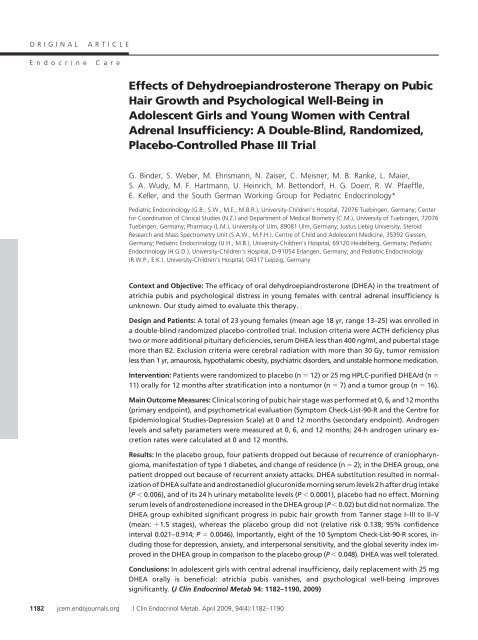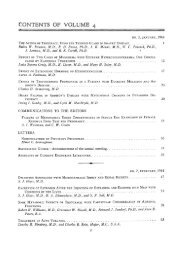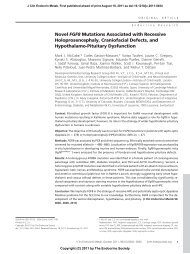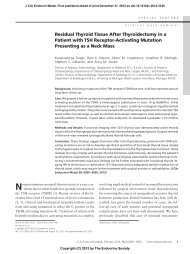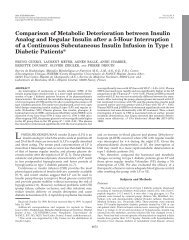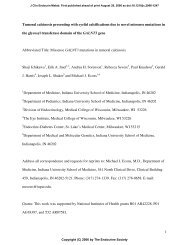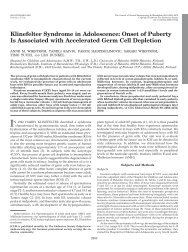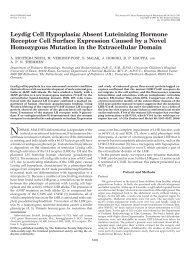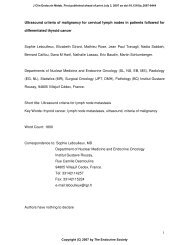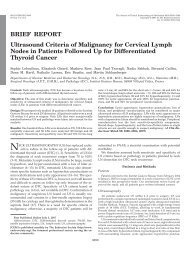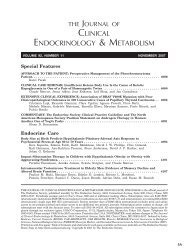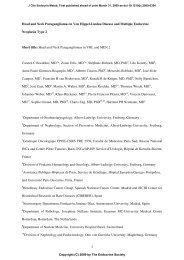Effects of Dehydroepiandrosterone Therapy on Pubic Hair Growth ...
Effects of Dehydroepiandrosterone Therapy on Pubic Hair Growth ...
Effects of Dehydroepiandrosterone Therapy on Pubic Hair Growth ...
You also want an ePaper? Increase the reach of your titles
YUMPU automatically turns print PDFs into web optimized ePapers that Google loves.
ORIGINAL ARTICLE<br />
Endocrine Care<br />
<str<strong>on</strong>g>Effects</str<strong>on</strong>g> <str<strong>on</strong>g>of</str<strong>on</strong>g> <str<strong>on</strong>g>Dehydroepiandroster<strong>on</strong>e</str<strong>on</strong>g> <str<strong>on</strong>g>Therapy</str<strong>on</strong>g> <strong>on</strong> <strong>Pubic</strong><br />
<strong>Hair</strong> <strong>Growth</strong> and Psychological Well-Being in<br />
Adolescent Girls and Young Women with Central<br />
Adrenal Insufficiency: A Double-Blind, Randomized,<br />
Placebo-C<strong>on</strong>trolled Phase III Trial<br />
G. Binder, S. Weber, M. Ehrismann, N. Zaiser, C. Meisner, M. B. Ranke, L. Maier,<br />
S. A. Wudy, M. F. Hartmann, U. Heinrich, M. Bettendorf, H. G. Doerr, R. W. Pfaeffle,<br />
E. Keller, and the South German Working Group for Pediatric Endocrinology*<br />
Pediatric Endocrinology (G.B., S.W., M.E., M.B.R.), University-Children’s Hospital, 72076 Tuebingen, Germany; Center<br />
for Coordinati<strong>on</strong> <str<strong>on</strong>g>of</str<strong>on</strong>g> Clinical Studies (N.Z.) and Department <str<strong>on</strong>g>of</str<strong>on</strong>g> Medical Biometry (C.M.), University <str<strong>on</strong>g>of</str<strong>on</strong>g> Tuebingen, 72076<br />
Tuebingen, Germany; Pharmacy (L.M.), University <str<strong>on</strong>g>of</str<strong>on</strong>g> Ulm, 89081 Ulm, Germany; Justus Liebig University, Steroid<br />
Research and Mass Spectrometry Unit (S.A.W., M.F.H.), Centre <str<strong>on</strong>g>of</str<strong>on</strong>g> Child and Adolescent Medicine, 35392 Giessen,<br />
Germany; Pediatric Endocrinology (U.H., M.B.), University-Children’s Hospital, 69120 Heidelberg, Germany; Pediatric<br />
Endocrinology (H.G.D.), University-Children’s Hospital, D-91054 Erlangen, Germany; and Pediatric Endocrinology<br />
(R.W.P., E.K.), University-Children’s Hospital, 04317 Leipzig, Germany<br />
C<strong>on</strong>text and Objective: The efficacy <str<strong>on</strong>g>of</str<strong>on</strong>g> oral dehydroepiandroster<strong>on</strong>e (DHEA) in the treatment <str<strong>on</strong>g>of</str<strong>on</strong>g><br />
atrichia pubis and psychological distress in young females with central adrenal insufficiency is<br />
unknown. Our study aimed to evaluate this therapy.<br />
Design and Patients: A total <str<strong>on</strong>g>of</str<strong>on</strong>g> 23 young females (mean age 18 yr, range 13–25) was enrolled in<br />
a double-blind randomized placebo-c<strong>on</strong>trolled trial. Inclusi<strong>on</strong> criteria were ACTH deficiency plus<br />
two or more additi<strong>on</strong>al pituitary deficiencies, serum DHEA less than 400 ng/ml, and pubertal stage<br />
more than B2. Exclusi<strong>on</strong> criteria were cerebral radiati<strong>on</strong> with more than 30 Gy, tumor remissi<strong>on</strong><br />
less than 1 yr, amaurosis, hypothalamic obesity, psychiatric disorders, and unstable horm<strong>on</strong>e medicati<strong>on</strong>.<br />
Interventi<strong>on</strong>: Patients were randomized to placebo (n 12) or 25 mg HPLC-purified DHEA/d (n <br />
11) orally for 12 m<strong>on</strong>ths after stratificati<strong>on</strong> into a n<strong>on</strong>tumor (n 7) and a tumor group (n 16).<br />
Main Outcome Measures: Clinical scoring <str<strong>on</strong>g>of</str<strong>on</strong>g> pubic hair stage was performed at 0, 6, and 12 m<strong>on</strong>ths<br />
(primary endpoint), and psychometrical evaluati<strong>on</strong> (Symptom Check-List-90-R and the Centre for<br />
Epidemiological Studies-Depressi<strong>on</strong> Scale) at 0 and 12 m<strong>on</strong>ths (sec<strong>on</strong>dary endpoint). Androgen<br />
levels and safety parameters were measured at 0, 6, and 12 m<strong>on</strong>ths; 24-h androgen urinary excreti<strong>on</strong><br />
rates were calculated at 0 and 12 m<strong>on</strong>ths.<br />
Results: In the placebo group, four patients dropped out because <str<strong>on</strong>g>of</str<strong>on</strong>g> recurrence <str<strong>on</strong>g>of</str<strong>on</strong>g> craniopharyngioma,<br />
manifestati<strong>on</strong> <str<strong>on</strong>g>of</str<strong>on</strong>g> type 1 diabetes, and change <str<strong>on</strong>g>of</str<strong>on</strong>g> residence (n 2); in the DHEA group, <strong>on</strong>e<br />
patient dropped out because <str<strong>on</strong>g>of</str<strong>on</strong>g> recurrent anxiety attacks. DHEA substituti<strong>on</strong> resulted in normalizati<strong>on</strong><br />
<str<strong>on</strong>g>of</str<strong>on</strong>g> DHEA sulfate and androstanediol glucur<strong>on</strong>ide morning serum levels 2 h after drug intake<br />
(P 0.006), and <str<strong>on</strong>g>of</str<strong>on</strong>g> its 24 h urinary metabolite levels (P 0.0001), placebo had no effect. Morning<br />
serum levels <str<strong>on</strong>g>of</str<strong>on</strong>g> androstenedi<strong>on</strong>e increased in the DHEA group (P 0.02) but did not normalize. The<br />
DHEA group exhibited significant progress in pubic hair growth from Tanner stage I–III to II–V<br />
(mean: 1.5 stages), whereas the placebo group did not (relative risk 0.138; 95% c<strong>on</strong>fidence<br />
interval 0.021–0.914; P 0.0046). Importantly, eight <str<strong>on</strong>g>of</str<strong>on</strong>g> the 10 Symptom Check-List-90-R scores, including<br />
those for depressi<strong>on</strong>, anxiety, and interpers<strong>on</strong>al sensitivity, and the global severity index improved<br />
in the DHEA group in comparis<strong>on</strong> to the placebo group (P 0.048). DHEA was well tolerated.<br />
C<strong>on</strong>clusi<strong>on</strong>s: In adolescent girls with central adrenal insufficiency, daily replacement with 25 mg<br />
DHEA orally is beneficial: atrichia pubis vanishes, and psychological well-being improves<br />
significantly. (J Clin Endocrinol Metab 94: 1182–1190, 2009)<br />
1182 jcem.endojournals.org J Clin Endocrinol Metab. April 2009, 94(4):1182–1190
J Clin Endocrinol Metab, April 2009, 94(4):1182–1190 jcem.endojournals.org 1183<br />
ACTH deficiency causes a deficient supply <str<strong>on</strong>g>of</str<strong>on</strong>g> the adrenal horm<strong>on</strong>es<br />
cortisol and dehydroepiandroster<strong>on</strong>e (DHEA). Although<br />
replacement <str<strong>on</strong>g>of</str<strong>on</strong>g> cortisol is standard in endocrine care for<br />
children and adults, treatment <str<strong>on</strong>g>of</str<strong>on</strong>g> DHEA deficiency is still a matter<br />
<str<strong>on</strong>g>of</str<strong>on</strong>g> discussi<strong>on</strong> (1). Impaired health-related quality <str<strong>on</strong>g>of</str<strong>on</strong>g> life in adults<br />
with adrenal insufficiency was reported, suggesting insufficient replacement<br />
therapy (2). Such data are missing for childhood and<br />
adolescence.<br />
DHEA is a prohorm<strong>on</strong>e <str<strong>on</strong>g>of</str<strong>on</strong>g> androgens and estrogens, and by<br />
95% <str<strong>on</strong>g>of</str<strong>on</strong>g> adrenal origin (3). In early childhood, DHEA producti<strong>on</strong><br />
is low until it gradually starts to increase between 6 and 10 yr <str<strong>on</strong>g>of</str<strong>on</strong>g><br />
age. This phenomen<strong>on</strong>, called adrenarche, is associated with expansi<strong>on</strong><br />
<str<strong>on</strong>g>of</str<strong>on</strong>g> the adrenal z<strong>on</strong>a reticularis (3). Peak DHEA serum c<strong>on</strong>centrati<strong>on</strong><br />
is reached in women at about 24 yr <str<strong>on</strong>g>of</str<strong>on</strong>g> age, followed by<br />
a steady decline, down to around 20% <str<strong>on</strong>g>of</str<strong>on</strong>g> the peak value (4).<br />
DHEA and its sulfate ester, DHEA sulfate (DHEAS), are secreted<br />
in very large amounts, and are the endocrine steroids with<br />
the highest serum c<strong>on</strong>centrati<strong>on</strong> in humans. Many peripheral<br />
target tissues are able to c<strong>on</strong>vert DHEA into sex horm<strong>on</strong>es (5).<br />
While androgens in males are mainly produced in the testes independent<br />
from DHEA producti<strong>on</strong> <str<strong>on</strong>g>of</str<strong>on</strong>g> the adrenals, androgens in<br />
females are to more than 75% c<strong>on</strong>versi<strong>on</strong> products <str<strong>on</strong>g>of</str<strong>on</strong>g> DHEA (6).<br />
Therefore, DHEA deficiency results in androgen deficiency in<br />
females (7). Childhood <strong>on</strong>set <str<strong>on</strong>g>of</str<strong>on</strong>g> complete adrenal insufficiency is<br />
regularly associated with atrichia pubis and lack <str<strong>on</strong>g>of</str<strong>on</strong>g> axillary hair<br />
in females because growth <str<strong>on</strong>g>of</str<strong>on</strong>g> sexual hair in females is completely<br />
dependent <strong>on</strong> the presence <str<strong>on</strong>g>of</str<strong>on</strong>g> the prohorm<strong>on</strong>e DHEA and its<br />
c<strong>on</strong>versi<strong>on</strong> product dihydrotestoster<strong>on</strong>e (8).<br />
Prospective l<strong>on</strong>g-term studies <strong>on</strong> the c<strong>on</strong>sequences <str<strong>on</strong>g>of</str<strong>on</strong>g> chr<strong>on</strong>ic<br />
DHEA deficiency with early <strong>on</strong>set do not exist. Randomized<br />
short-term studies in adults with adrenal insufficiency suggested<br />
a good safety pr<str<strong>on</strong>g>of</str<strong>on</strong>g>ile <str<strong>on</strong>g>of</str<strong>on</strong>g> DHEA at doses <str<strong>on</strong>g>of</str<strong>on</strong>g> 25–50 mg/d orally,<br />
which were able to normalize DHEA(S) serum levels in healthy<br />
c<strong>on</strong>trols after suppressi<strong>on</strong> <str<strong>on</strong>g>of</str<strong>on</strong>g> the adrenal gland (9). Positive effects<br />
<str<strong>on</strong>g>of</str<strong>on</strong>g> DHEA <strong>on</strong> well-being and sexuality in adult females with<br />
adrenal insufficiency that were shown in the first c<strong>on</strong>trolled<br />
short-term study (10) were c<strong>on</strong>firmed in most <str<strong>on</strong>g>of</str<strong>on</strong>g> the following<br />
short-term studies (11–13) and in <strong>on</strong>e l<strong>on</strong>g-term study (14), but<br />
not in all studies (15). In pediatric patients there are two small<br />
unc<strong>on</strong>trolled case studies reported <strong>on</strong> DHEAS (instead <str<strong>on</strong>g>of</str<strong>on</strong>g><br />
DHEA) therapy that suggested that this medicati<strong>on</strong> is able to<br />
induce pubarche in girls with adrenal insufficiency (7, 16). C<strong>on</strong>trolled<br />
studies in late childhood or adolescence do not exist at all.<br />
We hypothesized that medicati<strong>on</strong> with DHEA might be most<br />
useful and effective in females who are severely deficient <str<strong>on</strong>g>of</str<strong>on</strong>g><br />
DHEA and at an adolescent age when DHEA(S) reaches its physiological<br />
serum peak. Here, we report the data observed in a<br />
randomized c<strong>on</strong>trolled double-blind study that included adoles-<br />
ISSN Print 0021-972X ISSN Online 1945-7197<br />
Printed in U.S.A.<br />
Copyright © 2009 by The Endocrine Society<br />
doi: 10.1210/jc.2008-1982 Received September 8, 2008. Accepted December 30, 2008.<br />
First Published Online January 6, 2009<br />
* For a list <str<strong>on</strong>g>of</str<strong>on</strong>g> members <str<strong>on</strong>g>of</str<strong>on</strong>g> the South German Working Group for Pediatric Endocrinology,<br />
see Acknowledgments.<br />
cent girls and young women at ages between 13 and 26 yr with<br />
severe DHEA deficiency due to central adrenal insufficiency.<br />
Subjects and Methods<br />
Subjects<br />
Adolescent girls and young women at ages between 13 and 26 yr with<br />
the diagnosis <str<strong>on</strong>g>of</str<strong>on</strong>g> central adrenal insufficiency were enrolled in the study.<br />
The clinicians who decided to take part in this study were asked to screen<br />
all their patients with a chr<strong>on</strong>ic endocrine disorder for eligibility. This<br />
screening was d<strong>on</strong>e in four pediatric endocrinology departments at university<br />
hospital clinics by pediatric endocrinologists who are known to<br />
have very good expertise in diagnosis and therapy <str<strong>on</strong>g>of</str<strong>on</strong>g> hypopituitarism.<br />
Eligibility criteria were a pubertal breast stage B3 or more according to<br />
Tanner, DHEAS serum levels less than 400 ng/ml in two independent<br />
measurements (DHEA deficiency), proven central adrenal insufficiency,<br />
presence <str<strong>on</strong>g>of</str<strong>on</strong>g> at least two additi<strong>on</strong>al pituitary horm<strong>on</strong>e deficiencies, and no<br />
planned changes in medicati<strong>on</strong> during the study. Exclusi<strong>on</strong> criteria were<br />
cranial irradiati<strong>on</strong> with more than 30 Gy, hypothalamic obesity syndrome,<br />
amaurosis, mental retardati<strong>on</strong>, psychosis, systemic diseases like<br />
chr<strong>on</strong>ic hepatopathy and heart disorders, diabetes mellitus and elevated<br />
liver enzymes, as well as durati<strong>on</strong> <str<strong>on</strong>g>of</str<strong>on</strong>g> remissi<strong>on</strong> from a cerebral tumor<br />
shorter than 12 m<strong>on</strong>ths.<br />
The group c<strong>on</strong>sisted <str<strong>on</strong>g>of</str<strong>on</strong>g> seven patients with c<strong>on</strong>natal and 16 with acquired<br />
hypopituitarism after resecti<strong>on</strong> <str<strong>on</strong>g>of</str<strong>on</strong>g> a tumor <str<strong>on</strong>g>of</str<strong>on</strong>g> the sella regi<strong>on</strong>. The 16<br />
patients included 12 cases after surgery for a craniopharyngioma and four<br />
cases <str<strong>on</strong>g>of</str<strong>on</strong>g> other tumors <str<strong>on</strong>g>of</str<strong>on</strong>g> the sella regi<strong>on</strong> (in detail: two dysgerminomas, <strong>on</strong>e<br />
pituitary adenoma, and <strong>on</strong>e astrocytoma). All patients and parents <str<strong>on</strong>g>of</str<strong>on</strong>g> patients<br />
gave their written informed c<strong>on</strong>sent before enrollment.<br />
Study design<br />
This study was a randomized, double-blind, placebo-c<strong>on</strong>trolled, multicenter<br />
trial. We decided against the cross-over design for this study to<br />
avoid cross-over effects that were likely to occur. The study has been<br />
registered at www.clinicaltrials.gov. The trial was c<strong>on</strong>ducted in compliance<br />
with internati<strong>on</strong>al guidelines. The protocol was reviewed by the<br />
Ethics Committee <str<strong>on</strong>g>of</str<strong>on</strong>g> the Medical Faculty <str<strong>on</strong>g>of</str<strong>on</strong>g> Tuebingen and by the German<br />
Federal Institute for Drugs and Medical Devices. Adherence to good<br />
clinical practice in this multicenter trial was achieved by implementati<strong>on</strong><br />
<str<strong>on</strong>g>of</str<strong>on</strong>g> a standardized protocol, an investigator’s brochure, an operati<strong>on</strong>al<br />
manual with detailed instructi<strong>on</strong>s <strong>on</strong> how to perform each assessment,<br />
data collecti<strong>on</strong> <strong>on</strong> case record forms, several investigators’ meetings before<br />
starting the trial reviewing all procedures and assessments, an initiati<strong>on</strong><br />
visit at each site by a m<strong>on</strong>itor assistant, and <strong>on</strong>going m<strong>on</strong>itoring<br />
throughout the study to maintain the quality <str<strong>on</strong>g>of</str<strong>on</strong>g> data collected. Patients<br />
were randomized to receive either placebo or DHEA at a dose <str<strong>on</strong>g>of</str<strong>on</strong>g> 25 mg<br />
<strong>on</strong>ce a day in the morning orally for 12 m<strong>on</strong>ths. Both drugs, DHEA and<br />
placebo, were supplied as a sterile powder in identical capsules that did<br />
not provide any informati<strong>on</strong> <strong>on</strong> its c<strong>on</strong>tent to the user.<br />
DHEA and placebo<br />
DHEA used was produced by Synopharm GmbH (Barsbüttel, Germany)<br />
as a highly pure (HPLC c<strong>on</strong>tent 100%) powder. This chemical<br />
was encapsulated and distributed by the Pharmacy <str<strong>on</strong>g>of</str<strong>on</strong>g> the Medical Faculty<br />
<str<strong>on</strong>g>of</str<strong>on</strong>g> the University Ulm, Germany. The placebo used was D-mannitol<br />
Abbreviati<strong>on</strong>s: ADIOL, 5-Androstene-3,17-diol; CES-D, Centre for Epidemiological<br />
Studies-Depressi<strong>on</strong> Scale; DHEA, dehydroepiandroster<strong>on</strong>e; DHEAS, dehydroepiandroster<strong>on</strong>e<br />
sulfate; GC, gas chromatography; SCL-90-R, Symptom Check-List-90-R.
1184 Binder et al. DHEA Replacement in Young Females J Clin Endocrinol Metab, April 2009, 94(4):1182–1190<br />
99.5%/aerosol 0.5%. For the assessment <str<strong>on</strong>g>of</str<strong>on</strong>g> compliance, unused capsules<br />
were counted at each visit.<br />
Efficacy assessment<br />
In the current trial, we tested the hypothesis that oral administrati<strong>on</strong><br />
<str<strong>on</strong>g>of</str<strong>on</strong>g> 25 mg DHEA is able to promote impaired pubic hair growth (primary<br />
endpoint) and to decrease psychological distress (sec<strong>on</strong>dary endpoint 1),<br />
both caused by central adrenal insufficiency. In additi<strong>on</strong>, normalizati<strong>on</strong><br />
<str<strong>on</strong>g>of</str<strong>on</strong>g> adrenal androgen levels in serum 2 h after drug intake and in a 24-h<br />
urine collecti<strong>on</strong> were tested (sec<strong>on</strong>dary endpoint 2). Efficacy measurements<br />
were performed at baseline, and at 6 and 12 m<strong>on</strong>ths during<br />
therapy.<br />
The primary outcome measure with respect to efficacy was the proporti<strong>on</strong><br />
<str<strong>on</strong>g>of</str<strong>on</strong>g> patients with a change to a more mature pubic hair stage from<br />
baseline to m<strong>on</strong>th 12, as measured by Tanner stages. For clinical purposes,<br />
Tanner has separated the pubic hair development into five stages<br />
from stage PH1 (infantile) to stage PH5 (adult) (17) (Fig. 1). This staging<br />
is routinely used by pediatricians. All five clinical investigators involved<br />
are experienced pediatric endocrinologists who are very familiar with the<br />
staging <str<strong>on</strong>g>of</str<strong>on</strong>g> pubic hair according to Tanner.<br />
Sec<strong>on</strong>dary outcome measures were positive changes (calculated as<br />
the difference <str<strong>on</strong>g>of</str<strong>on</strong>g> each score) in well-being and mood from baseline to<br />
m<strong>on</strong>th 12 as measured by the German versi<strong>on</strong>s <str<strong>on</strong>g>of</str<strong>on</strong>g> the Symptom Check-<br />
List-90-R (SCL-90-R) and <str<strong>on</strong>g>of</str<strong>on</strong>g> the Centre for Epidemiological Studies-<br />
Depressi<strong>on</strong> Scale (CES-D). The SCL-90-R is a widely used, well-validated<br />
psychological status symptom inventory that measures the subjectively<br />
experienced distress by 90 given somatic and mental symptoms. The<br />
individual tested reports the symptoms experienced during the last 7 d.<br />
This inventory allows a multidimensi<strong>on</strong>al analysis and c<strong>on</strong>tains repeated<br />
measurements. The German versi<strong>on</strong> <str<strong>on</strong>g>of</str<strong>on</strong>g> SCL-90-R is well established, and<br />
reference data for schoolchildren and adolescents are available (18, 19).<br />
The other test used, the CES-D, is <strong>on</strong>e <str<strong>on</strong>g>of</str<strong>on</strong>g> the most frequently used and<br />
well-validated self-report screening tool for depressive symptoms.<br />
CES-D c<strong>on</strong>sists <str<strong>on</strong>g>of</str<strong>on</strong>g> 20 items assessing the frequency <str<strong>on</strong>g>of</str<strong>on</strong>g> depressive symp-<br />
FIG. 1. Participant flow throughout the study.<br />
toms during the preceding week. The German versi<strong>on</strong> <str<strong>on</strong>g>of</str<strong>on</strong>g> the CES-D is<br />
well established, and reference data for schoolchildren and adolescents<br />
are available (20, 21).<br />
Additi<strong>on</strong>al sec<strong>on</strong>dary outcome measures were the change to normalizati<strong>on</strong><br />
<str<strong>on</strong>g>of</str<strong>on</strong>g> serum androgen levels (DHEAS, androstenedi<strong>on</strong>e, testoster<strong>on</strong>e)<br />
2 h after drug intake and <str<strong>on</strong>g>of</str<strong>on</strong>g> the amount <str<strong>on</strong>g>of</str<strong>on</strong>g> urinary excreted androgens<br />
[DHEA, DHEA and M (16-hydroxylated downstream metabolites),<br />
5-androstene-3,17-diol (ADIOL), C19 (total androgen metabolites)].<br />
Serum samples were collected from the n<strong>on</strong>fasted patient in the morning<br />
before 1000 h during each visit (0, 6, and 12 m<strong>on</strong>ths), around 2 h after<br />
oral administrati<strong>on</strong> <str<strong>on</strong>g>of</str<strong>on</strong>g> DHEA at visits 6 and 12 m<strong>on</strong>ths. The samples<br />
were collectively assayed at the end <str<strong>on</strong>g>of</str<strong>on</strong>g> the trial to exclude changes <str<strong>on</strong>g>of</str<strong>on</strong>g><br />
measurements due to interassay variability. Serum DHEAS levels were<br />
measured using an automated chemiluminescence assay system (Immulite;<br />
DPC Biermann GmbH, Bad Nauheim, Germany). Intraassay coefficients<br />
ranged from 4.8–8.8%. Total serum testoster<strong>on</strong>e was measured<br />
by solid-phase 125J RIA in unextracted serum (Coat-A-Count total testoster<strong>on</strong>e;<br />
Diagnostic Products Corp., Los Angeles, CA). Cross-reactivity<br />
to natural steroids was by far less than 1%, to 5-dihydrotestoster<strong>on</strong>e<br />
3%. The intraassay coefficient was 6.0% according to the manufacturer.<br />
Androstenedi<strong>on</strong>e serum levels were determined by Active Androstenedi<strong>on</strong>e<br />
RIA (Diagnostics Systems Laboratories, Sinsheim, Germany). Cross-reactivity<br />
to natural androgens is less than 0.33%. The intraassay coefficient<br />
was 5.6% according to the manufacturer. The measurements <str<strong>on</strong>g>of</str<strong>on</strong>g> androstanediol<br />
glucur<strong>on</strong>ide levels in serum were performed using androstanediol<br />
glucur<strong>on</strong>ide RIA DSL-6000 (Diagnostics Systems Laboratories).<br />
Intraassay coefficients range from 4.2–8.2%. Reference values for the<br />
horm<strong>on</strong>e assays used were taken from three references (22–24). Serum<br />
SHBG levels were determined using the Immulite 1000 SHBG assay<br />
(Immulite). Intraassay coefficients ranged from 4.1–7.7% according to<br />
the manufacturer.<br />
Urinary pr<str<strong>on</strong>g>of</str<strong>on</strong>g>iling was performed at 0 and 12 m<strong>on</strong>ths. Patients and<br />
parents received instructi<strong>on</strong> and written guidance to ensure compliance<br />
in the 24 h-urine collecti<strong>on</strong> that was performed at home by each participant<br />
before the visits. The urinary steroid pr<str<strong>on</strong>g>of</str<strong>on</strong>g>iles were determined using<br />
quantitative data produced by gas chromatography (GC)-mass spectrometry<br />
analysis according to the method described previously (25). In<br />
brief, free and c<strong>on</strong>jugated urinary steroids were extracted by solid-phase<br />
extracti<strong>on</strong>, and the c<strong>on</strong>jugates were enzymatically hydrolyzed. Thereafter,<br />
steroids were again recovered by solid-phase extracti<strong>on</strong> and derivatized<br />
to form methyloxime-trimethylsilyl ethers. GC was performed<br />
using an Optima-1 fused silica column (Machery-Nagel, Dueren, Germany)<br />
and helium as carrier gas. The GC (Agilent 6890 Series GC; Agilent<br />
7683 Series Injector; Agilent Technologies, Inc., Palo Alto, CA) was<br />
directly interfaced to a mass selective detector (Agilent 5973N MSD)<br />
operated in selected i<strong>on</strong> m<strong>on</strong>itoring mode.<br />
Daily urinary excreti<strong>on</strong> rates were determined for DHEA, ADIOL,<br />
and the sum <str<strong>on</strong>g>of</str<strong>on</strong>g> DHEA and its 16-hydroxylated downstream metabolites<br />
16-hydroxy-DHEA and 3,16,17-androstenetriol (DHEA<br />
and M), reflecting major adrenarchal secreti<strong>on</strong> products. Overall androgen<br />
metabolite excreti<strong>on</strong> (C19) was determined as the sum <str<strong>on</strong>g>of</str<strong>on</strong>g><br />
androster<strong>on</strong>e, etiocholanol<strong>on</strong>e, ADIOL, DHEA, 16-hydroxy-<br />
DHEA, and 3,16,17-androstenetriol.<br />
Safety assessments<br />
The clinical assessment performed at every visit included physical<br />
examinati<strong>on</strong> with measurement <str<strong>on</strong>g>of</str<strong>on</strong>g> height, weight, blood pressure, serum<br />
chemistry, and complete blood count. We especially looked for the occurrence<br />
<str<strong>on</strong>g>of</str<strong>on</strong>g> acne and <str<strong>on</strong>g>of</str<strong>on</strong>g> hirsutism, which was quantified by the score<br />
proposed by Ferriman and Gallwey (26). Adverse events were m<strong>on</strong>itored<br />
and recorded throughout the study according to Good Clinical Practice<br />
guidelines.<br />
Sample size<br />
We estimated that the probability for a change <str<strong>on</strong>g>of</str<strong>on</strong>g> the pubic stage<br />
would be 5% in the placebo group and 50% in the DHEA group, according<br />
to the data from two small unc<strong>on</strong>trolled case studies <strong>on</strong> DHEAS
J Clin Endocrinol Metab, April 2009, 94(4):1182–1190 jcem.endojournals.org 1185<br />
(7, 16). Based <strong>on</strong> an -error level <str<strong>on</strong>g>of</str<strong>on</strong>g> 5% and -error level <str<strong>on</strong>g>of</str<strong>on</strong>g> 20% (<strong>on</strong>esided<br />
testing) to detect a change to a higher pubic stage, 12 patients were<br />
required for each study group. To compensate for a dropout rate <str<strong>on</strong>g>of</str<strong>on</strong>g><br />
10–20%, we planned to include 30 patients. Actually, recruitment was<br />
poorer than expected because some hospitals initially involved decided<br />
not to take part in the study because <str<strong>on</strong>g>of</str<strong>on</strong>g> the inability to manage the<br />
workload associated with this study. For partial compensati<strong>on</strong> <str<strong>on</strong>g>of</str<strong>on</strong>g> this<br />
event, the age range for inclusi<strong>on</strong> was extended from 13–23 yr to 13–26<br />
yr by the amendment No. 1 <str<strong>on</strong>g>of</str<strong>on</strong>g> the study protocol from April 2003.<br />
Allocati<strong>on</strong> sequence<br />
To achieve balance in respect to the medical history <str<strong>on</strong>g>of</str<strong>on</strong>g> the patients,<br />
randomizati<strong>on</strong> was stratified into a “tumor group” defined by a medical<br />
history <str<strong>on</strong>g>of</str<strong>on</strong>g> a cerebral tumor <str<strong>on</strong>g>of</str<strong>on</strong>g> the sella regi<strong>on</strong> (in remissi<strong>on</strong>), and a “n<strong>on</strong>tumor<br />
group” defined by c<strong>on</strong>natal hypopituitarism and absence <str<strong>on</strong>g>of</str<strong>on</strong>g> a<br />
history <str<strong>on</strong>g>of</str<strong>on</strong>g> a cerebral tumor. The allocati<strong>on</strong> sequence was defined by two<br />
computer-generated randomizati<strong>on</strong> lists (<strong>on</strong>e for each group) that were<br />
set up by a statistician <str<strong>on</strong>g>of</str<strong>on</strong>g> the Department <str<strong>on</strong>g>of</str<strong>on</strong>g> Medical Biometry Tuebingen,<br />
and were given to the pharmacy at the University <str<strong>on</strong>g>of</str<strong>on</strong>g> Ulm. These lists<br />
ensured that members <str<strong>on</strong>g>of</str<strong>on</strong>g> both groups had an equal probability to get<br />
DHEA or placebo (1:1). Independent pharmacists (University <str<strong>on</strong>g>of</str<strong>on</strong>g> Ulm,<br />
Pharmacy, Ulm, Germany) dispensed either placebo or DHEA according<br />
to these lists whose c<strong>on</strong>tent was not available for the researchers. The<br />
researchers were completely blinded for the c<strong>on</strong>tent <str<strong>on</strong>g>of</str<strong>on</strong>g> the capsules allocated<br />
to each patient from the time <str<strong>on</strong>g>of</str<strong>on</strong>g> allocati<strong>on</strong> until the end <str<strong>on</strong>g>of</str<strong>on</strong>g> the<br />
trial. The code <str<strong>on</strong>g>of</str<strong>on</strong>g> each study drug was revealed to the researchers after<br />
the end <str<strong>on</strong>g>of</str<strong>on</strong>g> the trial, when the total data set was saved and blocked against<br />
any subsequent changes by a statistician.<br />
Statistical analysis<br />
The primary endpoint was the change in pubic hair stage in the treatment<br />
group compared with the placebo group. The efficacy <str<strong>on</strong>g>of</str<strong>on</strong>g> the therapy<br />
was statistically evaluated using the Cochran-Mantel-Haenszel- 2<br />
test (27), including the estimati<strong>on</strong> <str<strong>on</strong>g>of</str<strong>on</strong>g> the relative risk, its 95% c<strong>on</strong>fidence<br />
interval, and two-sided P values. Analyses <str<strong>on</strong>g>of</str<strong>on</strong>g> changes in the psychological<br />
scores and changes in serum and urinary horm<strong>on</strong>e levels were performed<br />
using the two-sided Wilcox<strong>on</strong> test. All analyses were performed<br />
TABLE 1. Baseline characteristics <str<strong>on</strong>g>of</str<strong>on</strong>g> the study participants<br />
during the 12-m<strong>on</strong>th c<strong>on</strong>trolled study phase for the changes between<br />
pre-therapy visit and follow-up visit at 12 m<strong>on</strong>ths. Patients with missing<br />
values at the 12-m<strong>on</strong>th visit were included in the analyses with the last<br />
observed value before the planned time point (at the 6 m<strong>on</strong>th visit). All<br />
sec<strong>on</strong>dary endpoints were analyzed in an explorative sense.<br />
After collecti<strong>on</strong> <strong>on</strong> case record forms, all data were entered twice into<br />
the koordobas database (www.koordobas.de) by two independent study<br />
assistants. Koordobas is a validated s<str<strong>on</strong>g>of</str<strong>on</strong>g>tware for support <str<strong>on</strong>g>of</str<strong>on</strong>g> organizati<strong>on</strong><br />
and data management <str<strong>on</strong>g>of</str<strong>on</strong>g> clinical studies according to comm<strong>on</strong> requirements<br />
for c<strong>on</strong>ducti<strong>on</strong> <str<strong>on</strong>g>of</str<strong>on</strong>g> studies (Internati<strong>on</strong>al C<strong>on</strong>ference <str<strong>on</strong>g>of</str<strong>on</strong>g> Harm<strong>on</strong>izati<strong>on</strong>/Good<br />
Clinical Practice, Food and Drug Administrati<strong>on</strong>). Clean<br />
files were submitted to the Department <str<strong>on</strong>g>of</str<strong>on</strong>g> Medical Biometry at the University<br />
<str<strong>on</strong>g>of</str<strong>on</strong>g> Tuebingen for the final analysis, which was performed using<br />
the statistical analyzing s<str<strong>on</strong>g>of</str<strong>on</strong>g>tware SAS (versi<strong>on</strong> 9.1.3; SAS Institute Inc.,<br />
Cary, NC), based <strong>on</strong> the intenti<strong>on</strong>-to-treat populati<strong>on</strong>, which included<br />
all randomized patients with the excepti<strong>on</strong> <str<strong>on</strong>g>of</str<strong>on</strong>g> those who were withdrawn<br />
from active treatment before the first assessment <str<strong>on</strong>g>of</str<strong>on</strong>g> efficacy (Fig. 1).<br />
Role <str<strong>on</strong>g>of</str<strong>on</strong>g> the funding source<br />
The sp<strong>on</strong>sor was the Medical Faculty <str<strong>on</strong>g>of</str<strong>on</strong>g> the University <str<strong>on</strong>g>of</str<strong>on</strong>g> Tuebingen.<br />
The study protocol was reviewed, and the revised versi<strong>on</strong> was finally<br />
selected for support by a board <str<strong>on</strong>g>of</str<strong>on</strong>g> full pr<str<strong>on</strong>g>of</str<strong>on</strong>g>essors <str<strong>on</strong>g>of</str<strong>on</strong>g> the Medical Faculty.<br />
There was no c<strong>on</strong>tributi<strong>on</strong> to c<strong>on</strong>duct, data collecti<strong>on</strong>, data analysis, or<br />
anything else by the sp<strong>on</strong>sor.<br />
Results<br />
The participant flow throughout the study is shown in Fig. 1: 21 <str<strong>on</strong>g>of</str<strong>on</strong>g><br />
23 patients (91%) completed the visit at 6 m<strong>on</strong>th treatment, and 18<br />
<str<strong>on</strong>g>of</str<strong>on</strong>g> 23 patients (78%) completed the total trial lasting 12 m<strong>on</strong>ths.<br />
There was <strong>on</strong>e case <str<strong>on</strong>g>of</str<strong>on</strong>g> dropout in the DHEA group because <str<strong>on</strong>g>of</str<strong>on</strong>g><br />
recurrent anxiety attacks that occurred after a frightening ride in<br />
an amusement park carousel. Similar psychological problems<br />
had occurred before the trial but had not been reported to the doctor<br />
Placebo group (n 12) DHEA group (n 11)<br />
Age (range) 19.7 4.3 yr (13.1–25.4) 18.0 1.5 yr (15.7–21.0)<br />
Height (range) 168.1 5.6 cm (155.8–174.8) 162.2 6.1 cm (149.7–169.1)<br />
Weight (range) 66.6 16.4 kg (42.0–99.3) 68.6 15.6 kg (51.8–93.5)<br />
BMI (range) 23.4 4.8 kg/m 2 (17.3–33.1) 26.0 5.3 kg/m 2 (19.4–35.0)<br />
No. <str<strong>on</strong>g>of</str<strong>on</strong>g> overweight (BMI P90) 2 0<br />
No. with obesity (BMI P97) 2 5<br />
Systolic blood pressure (mm Hg) 113 12 115 12<br />
Diastolic blood pressure (mm Hg) 72 6 72 7<br />
No. with cerebral tumor 8 8<br />
No. with post-radiati<strong>on</strong> 2 4<br />
Hydrocortis<strong>on</strong>e dose (mg/m 2 d) 5.1 2.2 6.0 2.1<br />
No. with GH deficiency 12 11<br />
RhGH dose (g/m 2 d) 0.38 0.20 0.28 0.19<br />
No. with TSH deficiency 12 10<br />
L-thyroxine dose (g/m 2 d) 40.4 8.2 42.7 10.9<br />
LH/FSH deficiency 12 11<br />
ADH deficiency 6 7<br />
PRL deficiency 0 1<br />
Breast stage B (range) 4.5 0.8 (3–5) 4.6 0.7 (3–5)<br />
No. with pubic hair stage PH1 4 5<br />
No. with pubic hair stage PH2 7 4<br />
No. with pubic hair stage PH3 1 1<br />
No. with pubic hair stage PH4 0 1<br />
Drug doses are given per day and m 2 body surface. Data are means SD, if not otherwise stated. ADH, Antidiuretic horm<strong>on</strong>e; BMI, body mass index; PRL, prolactin;<br />
RhGH, recombinant human GH.
1186 Binder et al. DHEA Replacement in Young Females J Clin Endocrinol Metab, April 2009, 94(4):1182–1190<br />
at inclusi<strong>on</strong>. In the placebo group, <strong>on</strong>e withdrawal was caused<br />
by relapse <str<strong>on</strong>g>of</str<strong>on</strong>g> craniopharyngioma, another due to the manifestati<strong>on</strong><br />
<str<strong>on</strong>g>of</str<strong>on</strong>g> type 1 diabetes mellitus. Two patients with placebo<br />
were lost at follow-up because <str<strong>on</strong>g>of</str<strong>on</strong>g> change in residence<br />
after 6 m<strong>on</strong>th therapy. The remaining 18 patients completed<br />
the trial.<br />
Recruitment was started in January 2004 and ended in March<br />
2006. All 23 patients attended the clinic at baseline after recruitment<br />
and randomizati<strong>on</strong>. There were 21 patients seen at the 6<br />
m<strong>on</strong>th visit, and 18 completed the trial at the 12 m<strong>on</strong>th visit. The<br />
last patient had her 12-m<strong>on</strong>th visit in April 2007.<br />
Study populati<strong>on</strong><br />
Baseline characteristics <str<strong>on</strong>g>of</str<strong>on</strong>g> the randomized study participants<br />
are shown in Table 1. The groups were well balanced<br />
with respect to age, weight, tumor and radiati<strong>on</strong> history, presence<br />
<str<strong>on</strong>g>of</str<strong>on</strong>g> additi<strong>on</strong>al pituitary horm<strong>on</strong>e deficiencies, doses <str<strong>on</strong>g>of</str<strong>on</strong>g><br />
horm<strong>on</strong>es substituted, and pubic hair stage. All 23 patients<br />
had hypog<strong>on</strong>adotropic hypog<strong>on</strong>adism and were substituted<br />
with sex steroids. The <strong>on</strong>ly clinical characteristic that was<br />
different between the two groups was height (the placebo<br />
group was taller), which was presumably <str<strong>on</strong>g>of</str<strong>on</strong>g> no clinical relevance<br />
for this study.<br />
The analyses <str<strong>on</strong>g>of</str<strong>on</strong>g> the primary and sec<strong>on</strong>dary outcome measures<br />
involved all patients who took part in the 6-m<strong>on</strong>th visit and<br />
FIG. 2. Chr<strong>on</strong>ological changes <str<strong>on</strong>g>of</str<strong>on</strong>g> the pubic hair stage according to Tanner. Each filled circle represents<br />
<strong>on</strong>e individual patient. <strong>Pubic</strong> hair stage V (PH5) is normal in females with an age above 13 yr.<br />
excluded the two patients who were withdrawn from active<br />
treatment before the first assessment <str<strong>on</strong>g>of</str<strong>on</strong>g> efficacy. Treatment compliance<br />
was good; the counts <str<strong>on</strong>g>of</str<strong>on</strong>g> unused capsules were in good<br />
agreement to the expected numbers. In additi<strong>on</strong>, no relevant<br />
violati<strong>on</strong> <str<strong>on</strong>g>of</str<strong>on</strong>g> the study protocol was noted.<br />
Primary efficacy outcome<br />
The chr<strong>on</strong>ological change <str<strong>on</strong>g>of</str<strong>on</strong>g> the pubic hair stage in each individual<br />
treated is shown in Fig. 2. The DHEA group exhibited<br />
a significant progress in pubic hair growth from Tanner stage<br />
I–III to II–V (mean: 1 1 ⁄2 stages), whereas the placebo group<br />
did not (mean: 0stages) (P0.0046). Progress in pubic hair stage<br />
was observed in nine <str<strong>on</strong>g>of</str<strong>on</strong>g> 10 patients in the DHEA group, but <strong>on</strong>ly<br />
in three <str<strong>on</strong>g>of</str<strong>on</strong>g> 11 patients in the placebo group (relative risk: 0.138;<br />
95% c<strong>on</strong>fidence interval 0.021–0.914; P 0.0046). In the<br />
DHEA group, five adolescents reached the mature pubic hair<br />
stages IV and V, whereas <strong>on</strong>ly <strong>on</strong>e individual did in the placebo<br />
group.<br />
Sec<strong>on</strong>dary efficacy outcomes<br />
The psychometric measurement <str<strong>on</strong>g>of</str<strong>on</strong>g> psychological distress using<br />
the SCL-90-R at baseline and after 12 m<strong>on</strong>th therapy gave<br />
different results in the DHEA group when compared with the<br />
placebo group. We evaluated the psychological distress at baseline<br />
and after 12 m<strong>on</strong>th therapy, and calculated the differences<br />
<str<strong>on</strong>g>of</str<strong>on</strong>g> the scores observed. The values are<br />
shown in Table 2. At the start, the DHEA<br />
group scored higher than the placebo<br />
group in all scales, but differences were not<br />
significant. In all 10 scores, the DHEA<br />
group improved during therapy, whereas<br />
the placebo group worsened. These<br />
changes were significantly different in<br />
eight <str<strong>on</strong>g>of</str<strong>on</strong>g> 10 scores, including the global severity<br />
index, which is the central integrating<br />
score <str<strong>on</strong>g>of</str<strong>on</strong>g> this psychometric test. Baseline<br />
and outcome scores <str<strong>on</strong>g>of</str<strong>on</strong>g> both groups<br />
were within the normal range observed in<br />
the reference populati<strong>on</strong> (19).<br />
We used an additi<strong>on</strong>al psychometric instrument,<br />
the German versi<strong>on</strong> <str<strong>on</strong>g>of</str<strong>on</strong>g> the CES-D,<br />
to observe the presence <str<strong>on</strong>g>of</str<strong>on</strong>g> depressive symptoms<br />
in each patient treated. The effects <str<strong>on</strong>g>of</str<strong>on</strong>g><br />
the treatment were evaluated by comparis<strong>on</strong><br />
<str<strong>on</strong>g>of</str<strong>on</strong>g> changes in the CES-D sum score. The<br />
treatment group improved by 2.1 points<br />
(6.8; range 11 to 13) between baseline<br />
and the 12-m<strong>on</strong>th visit (P 0.316; n 10).<br />
In the c<strong>on</strong>trol group, the scores decreased<br />
[mean: 7.9, (12.0; range 38 to 5; P <br />
0.027; n 9]. The comparis<strong>on</strong> <str<strong>on</strong>g>of</str<strong>on</strong>g> the score<br />
changes with the Wilcox<strong>on</strong> test resulted in a<br />
P value <str<strong>on</strong>g>of</str<strong>on</strong>g> 0.018.<br />
The changes in serum and urinary androgens<br />
that were additi<strong>on</strong>al sec<strong>on</strong>dary out-<br />
come measures are shown in Fig. 3. DHEA<br />
substituti<strong>on</strong> resulted in normalizati<strong>on</strong> <str<strong>on</strong>g>of</str<strong>on</strong>g>
J Clin Endocrinol Metab, April 2009, 94(4):1182–1190 jcem.endojournals.org 1187<br />
TABLE 2. Scores <strong>on</strong> the SCL-90-R at baseline and after 12 m<strong>on</strong>th treatment with DHEA or placebo<br />
Scale Baseline 12 m<strong>on</strong>ths P value Reference<br />
Somatizati<strong>on</strong> 0.66 0.51<br />
Placebo 0.41 0.37 0.81 0.63 0.40 0.52<br />
DHEA 0.58 0.40 0.49 0.39 0.09 0.39 ns<br />
Obsessive-compulsive traits 0.77 0.54<br />
Placebo 0.43 0.41 0.61 0.63 0.18 0.38<br />
DHEA 0.81 0.56 0.46 0.39 0.35 0.41 0.049<br />
Interpers<strong>on</strong>al sensitivity 0.80 0.62<br />
Placebo 0.55 0.60 0.64 0.77 0.09 0.33<br />
DHEA 1.06 0.66 0.53 0.48 0.53 0.49 0.030<br />
Depressi<strong>on</strong> 0.77 0.59<br />
Placebo 0.48 0.49 0.80 0.83 0.32 0.64<br />
DHEA 0.78 0.54 0.45 0.58 0.33 0.41 0.049<br />
Anxiety 0.67 0.57<br />
Placebo 0.38 0.30 0.66 0.48 0.28 0.35<br />
DHEA 0.50 0.45 0.29 0.24 0.21 0.36 0.016<br />
Hostility 0.80 0.72<br />
Placebo 0.29 0.36 0.41 0.57 0.12 0.38<br />
DHEA 0.62 0.39 0.50 0.48 0.12 0.45 ns<br />
Phobic anxiety 0.25 0.33<br />
Placebo 0.13 0.17 0.32 0.51 0.19 0.36<br />
DHEA 0.40 0.49 0.17 0.32 0.23 0.12 0.011<br />
Paranoid ideati<strong>on</strong> 0.72 0.63<br />
Placebo 0.26 0.33 0.61 0.75 0.35 0.45<br />
DHEA 0.55 0.44 0.38 0.47 0.17 0.39 0.034<br />
Psychotic tendencies 0.46 0.53<br />
Placebo 0.20 0.28 0.46 0.47 0.26 0.31<br />
DHEA 0.31 0.31 0.19 0.31 0.12 0.29 0.036<br />
Global severity index 0.67 0.45<br />
Placebo 0.38 0.35 0.65 0.57 0.27 0.35<br />
DHEA 0.63 0.37 0.38 0.37 0.25 0.26 0.013<br />
Reference data shown are from 139 randomly chosen German schoolgirls with an age between 16 and 17 yr (19). ns, Not significant.<br />
DHEAS and androstanediol glucur<strong>on</strong>ide morning serum levels<br />
2 h after drug intake; placebo had no effect (P 0.006)<br />
(Fig. 3A). Morning serum levels <str<strong>on</strong>g>of</str<strong>on</strong>g> androstenedi<strong>on</strong>e increased<br />
significantly in the DHEA group <strong>on</strong>ly but did not normalize<br />
(P 0.02). Testoster<strong>on</strong>e serum levels increased <strong>on</strong>ly in two<br />
individuals and normalized in <strong>on</strong>ly <strong>on</strong>e <str<strong>on</strong>g>of</str<strong>on</strong>g> the DHEA group<br />
(Fig. 3A). SHBG and IGF-I serum levels remained unchanged<br />
(data not shown).<br />
In urine, daily excreti<strong>on</strong> rates for DHEA, ADIOL, and the<br />
sum <str<strong>on</strong>g>of</str<strong>on</strong>g> DHEA and its 16-hydroxylated downstream metabolites<br />
(DHEA and M) normalized in the DHEA group, but not in the<br />
placebo group (Fig. 3B). In additi<strong>on</strong>, the overall androgen metabolite<br />
excreti<strong>on</strong> (C19) was in the high-normal range in the<br />
DHEA group but stayed pathologically low in the placebo group<br />
(P 0.0001 for all comparis<strong>on</strong>s).<br />
Adverse events<br />
The proporti<strong>on</strong> <str<strong>on</strong>g>of</str<strong>on</strong>g> patients experiencing any adverse event<br />
was similar between the DHEA and placebo groups. Single adverse<br />
events reported in the DHEA group were a fracture <str<strong>on</strong>g>of</str<strong>on</strong>g> a<br />
finger, rhinitis, upper airway infecti<strong>on</strong>, and transient pain <str<strong>on</strong>g>of</str<strong>on</strong>g> the<br />
ankle joint. One girl in the DHEA group developed a mild moustache,<br />
but no other signs <str<strong>on</strong>g>of</str<strong>on</strong>g> hirsutism. Her Ferriman score was<br />
normal (n 2). Acne was not observed in any patient. In the<br />
placebo group, headache, n<strong>on</strong>organic acral paresthesias (n 2),<br />
mood swings, and spraining <str<strong>on</strong>g>of</str<strong>on</strong>g> the ankle were reported.<br />
There was <strong>on</strong>e severe adverse event in the DHEA group and<br />
two in the placebo group: <strong>on</strong>e girl suffered from recurrent anxiety<br />
attacks that were reported after 4 m<strong>on</strong>th therapy. Similar<br />
psychological problems had occurred before the trial according<br />
to the parents. Nevertheless, because causality could not be excluded,<br />
medicati<strong>on</strong> was stopped. In the placebo group, <strong>on</strong>e girl<br />
had a relapse <str<strong>on</strong>g>of</str<strong>on</strong>g> craniopharyngioma, and another exhibited the<br />
first manifestati<strong>on</strong> <str<strong>on</strong>g>of</str<strong>on</strong>g> type 1 diabetes mellitus. In both cases,<br />
medicati<strong>on</strong> was stopped. Overall, the safety pr<str<strong>on</strong>g>of</str<strong>on</strong>g>ile <str<strong>on</strong>g>of</str<strong>on</strong>g> DHEA<br />
was very good.<br />
Discussi<strong>on</strong><br />
Oral administrati<strong>on</strong> <str<strong>on</strong>g>of</str<strong>on</strong>g> 25 mg DHEA daily for 1 yr in a group <str<strong>on</strong>g>of</str<strong>on</strong>g><br />
female adolescents who suffered from central adrenal insufficiency<br />
caused a clear progress <str<strong>on</strong>g>of</str<strong>on</strong>g> pubic hair stage by I–III stages,<br />
whereas placebo had no effect. Psychological distress as measured<br />
by SCL-90 scores decreased when DHEA was substituted<br />
but increased in the placebo group. In additi<strong>on</strong>, the CES-D score<br />
that measures the presence <str<strong>on</strong>g>of</str<strong>on</strong>g> depressive symptoms improved in<br />
the treatment group but decreased in the placebo group. These<br />
effects were associated with normalizati<strong>on</strong> <str<strong>on</strong>g>of</str<strong>on</strong>g> the morning serum<br />
levels <str<strong>on</strong>g>of</str<strong>on</strong>g> DHEA and androstanediol glucur<strong>on</strong>ide 2 h after drug<br />
intake, as well as normalizati<strong>on</strong> <str<strong>on</strong>g>of</str<strong>on</strong>g> the 24-h urinary excreti<strong>on</strong> rates<br />
<str<strong>on</strong>g>of</str<strong>on</strong>g> DHEA, DHEA and M, ADIOL, and C19-metabolites in the
1188 Binder et al. DHEA Replacement in Young Females J Clin Endocrinol Metab, April 2009, 94(4):1182–1190<br />
FIG. 3. Chr<strong>on</strong>ological changes <str<strong>on</strong>g>of</str<strong>on</strong>g> the androgen levels in serum (A) and the daily androgen amount<br />
excreted in the urine (B) from baseline to 12 m<strong>on</strong>th therapy. The boxes indicate the 50% c<strong>on</strong>fidence<br />
interval, whiskers the 100% c<strong>on</strong>fidence interval, and lines inside the boxes the median. The grayshadowed<br />
areas represent the 90% c<strong>on</strong>fidence interval <str<strong>on</strong>g>of</str<strong>on</strong>g> a healthy age-related female reference<br />
populati<strong>on</strong> (22–25).<br />
DHEA group, whereas these parameters remained pathologically<br />
low in the placebo group. DHEA therapy was safe and well<br />
tolerated.<br />
Adolescence is the time <str<strong>on</strong>g>of</str<strong>on</strong>g> the <strong>on</strong>ly DHEA peak during the<br />
human life span. The normal mean serum DHEAS level at this<br />
age is at 2000 ng/ml. Therefore, DHEA deficiency is most severe<br />
when adolescent individuals are affected by adrenal insufficiency:<br />
our patients had serum DHEAS levels less than 200 ng/ml.<br />
The therapeutic substituti<strong>on</strong> <str<strong>on</strong>g>of</str<strong>on</strong>g> a severe deficiency for a horm<strong>on</strong>e<br />
should cause positive effects if the horm<strong>on</strong>e is <str<strong>on</strong>g>of</str<strong>on</strong>g> any<br />
relevant physiological value for the human being. DHEA is the<br />
major source <str<strong>on</strong>g>of</str<strong>on</strong>g> androgens in females.<br />
Most <str<strong>on</strong>g>of</str<strong>on</strong>g> the girls treated had no pubarche<br />
or an immature stage <str<strong>on</strong>g>of</str<strong>on</strong>g> pubic hair development<br />
because <str<strong>on</strong>g>of</str<strong>on</strong>g> a lack <str<strong>on</strong>g>of</str<strong>on</strong>g> androgens at<br />
baseline. They experienced a clear<br />
progress <str<strong>on</strong>g>of</str<strong>on</strong>g> sexual hair growth during the<br />
trial.<br />
Interestingly, these clinical changes<br />
happened in the absence <str<strong>on</strong>g>of</str<strong>on</strong>g> a measurable<br />
normalizati<strong>on</strong> <str<strong>on</strong>g>of</str<strong>on</strong>g> testoster<strong>on</strong>e in the morning<br />
serum, whereas the overall androgen<br />
metabolite excreti<strong>on</strong> in the urine (C19 metabolites)<br />
reached a normal level. In additi<strong>on</strong>,<br />
morning serum levels <str<strong>on</strong>g>of</str<strong>on</strong>g> androstanediol<br />
glucur<strong>on</strong>ide normalized in the DHEA<br />
group, which has been proposed as a marker<br />
<str<strong>on</strong>g>of</str<strong>on</strong>g> peripheral androgen producti<strong>on</strong> and acti<strong>on</strong><br />
(28). These observati<strong>on</strong>s suggest that<br />
normalizati<strong>on</strong> <str<strong>on</strong>g>of</str<strong>on</strong>g> morning serum DHEAS<br />
and androstenedi<strong>on</strong>e was sufficient to increase<br />
locally produced testoster<strong>on</strong>e and dihydrotestoster<strong>on</strong>e<br />
to an extent that enabled<br />
sexual hair growth. The same discrepancy<br />
between normal amounts <str<strong>on</strong>g>of</str<strong>on</strong>g> androgen metabolites<br />
and low-active androgens has been<br />
observed in DHEA trials with DHEA-deficient<br />
women or healthy postmenopausal<br />
women in the past (10, 29).<br />
Beside sexual hair growth in puberty,<br />
we could c<strong>on</strong>firm that DHEA and androgens<br />
have beneficial effects <strong>on</strong> the psychological<br />
well-being. The exact biochemical<br />
path that is used by DHEA to cause such<br />
effects is still obscure, and a separati<strong>on</strong><br />
from effects caused by metabolites <str<strong>on</strong>g>of</str<strong>on</strong>g><br />
DHEA is difficult. Such effects are <str<strong>on</strong>g>of</str<strong>on</strong>g> most<br />
importance in young patients having a<br />
chr<strong>on</strong>ic disease.<br />
This is the first c<strong>on</strong>trolled trial analyzing<br />
replacement <str<strong>on</strong>g>of</str<strong>on</strong>g> DHEA in pediatric patients.<br />
Craen et al. (16) reported <strong>on</strong> the individual<br />
treatment results in six girls who had hypopituitarism<br />
and low DHEAS serum levels using<br />
15 mg DHEAS /m 2 body surface. Central<br />
adrenal insufficiency was present in some,<br />
but not in all, <str<strong>on</strong>g>of</str<strong>on</strong>g> these patients according to<br />
the abstract published (16). Durati<strong>on</strong> <str<strong>on</strong>g>of</str<strong>on</strong>g> treatment was between<br />
6 and 28 m<strong>on</strong>ths. In this preliminary report, they observed<br />
an increase <str<strong>on</strong>g>of</str<strong>on</strong>g> serum DHEAS and a progress <str<strong>on</strong>g>of</str<strong>on</strong>g> pubic<br />
hair development to PH2 or more in all patients. Wit et al. (8)<br />
reported their experience with the individual treatment <str<strong>on</strong>g>of</str<strong>on</strong>g> four<br />
girls with central or peripheral adrenal insufficiency (age<br />
range 15–17.3 yr) using DHEAS at a dose <str<strong>on</strong>g>of</str<strong>on</strong>g> 25–50 mg orally.<br />
Treatment durati<strong>on</strong> was between 2 and 4 yr. They reported a<br />
positive effect <strong>on</strong> pubic hair development and normalizati<strong>on</strong><br />
<str<strong>on</strong>g>of</str<strong>on</strong>g> DHEAS serum levels. Adverse effects <str<strong>on</strong>g>of</str<strong>on</strong>g> DHEAS were not<br />
reported in these two studies.
J Clin Endocrinol Metab, April 2009, 94(4):1182–1190 jcem.endojournals.org 1189<br />
FIG. 3. (C<strong>on</strong>tinued).<br />
Instead <str<strong>on</strong>g>of</str<strong>on</strong>g> DHEAS, we administered DHEA, which has been<br />
used in all recent clinical trials in adult patients with adrenal<br />
insufficiency. In c<strong>on</strong>trast to DHEAS, the pharmacology <str<strong>on</strong>g>of</str<strong>on</strong>g><br />
DHEA has been well studied in adults (9), and it is easily available.<br />
By using the lowest dose reported to being effective in adult<br />
females with adrenal insufficiency (12), DHEAS serum levels<br />
were reached that were almost identical to the healthy reference<br />
populati<strong>on</strong> at this adolescent age. In comparis<strong>on</strong>, when adult<br />
females with a mean/median age between 40 and 57 yr <str<strong>on</strong>g>of</str<strong>on</strong>g> age<br />
were treated with 25–50 mg DHEA, DHEAS serum levels<br />
reached were in median around 2000 ng/ml ( 5.4 mol/liter),<br />
which is a c<strong>on</strong>centrati<strong>on</strong> above the median for this age (10–15).<br />
In this c<strong>on</strong>text it must be noted that oral<br />
DHEA replacement <strong>on</strong>ce daily does not fully<br />
restore the diurnal rhythm <str<strong>on</strong>g>of</str<strong>on</strong>g> serum androgen<br />
levels present in healthy women. Arlt et<br />
al. (9) studied the pharmacokinetics in<br />
healthy women (mean age 23.3 yr) with<br />
transient suppressi<strong>on</strong> <str<strong>on</strong>g>of</str<strong>on</strong>g> adrenal androgen<br />
secreti<strong>on</strong> because <str<strong>on</strong>g>of</str<strong>on</strong>g> dexamethas<strong>on</strong>e administrati<strong>on</strong>.<br />
Using this experimental setting,<br />
they found supraphysiological c<strong>on</strong>centrati<strong>on</strong>s<br />
<str<strong>on</strong>g>of</str<strong>on</strong>g> DHEAS during the first 12 h after<br />
oral administrati<strong>on</strong> <str<strong>on</strong>g>of</str<strong>on</strong>g> 50 mg DHEA, which<br />
decreased to baseline values during the<br />
sec<strong>on</strong>d half <str<strong>on</strong>g>of</str<strong>on</strong>g> the day. Similar kinetics was<br />
found for androstenedi<strong>on</strong>e and testoster<strong>on</strong>e;<br />
however, these androgen serum c<strong>on</strong>centrati<strong>on</strong>s<br />
did not reach baseline at any<br />
time. Therefore, the normalizati<strong>on</strong> <str<strong>on</strong>g>of</str<strong>on</strong>g><br />
morning serum levels in our DHEA group<br />
observed might not have been associated<br />
with normal serum levels during the whole<br />
day.<br />
In this study, adolescents and young<br />
adults with female gender <strong>on</strong>ly were treated.<br />
Therefore, results cannot be generalized to<br />
both genders. In male adolescents, androgens<br />
produced in testes may substitute for<br />
the missing adrenal androgens. Whether<br />
DHEA deficiency causes a relevant estrogen<br />
deficiency in adult males is still a matter <str<strong>on</strong>g>of</str<strong>on</strong>g><br />
debate. In pediatrics, data are missing to<br />
support such a hypothesis. We restricted the<br />
inclusi<strong>on</strong> to those children with adrenal insufficiency<br />
caused by ACTH deficiency.<br />
Therefore, the rare cases <str<strong>on</strong>g>of</str<strong>on</strong>g> primary adrenal<br />
insufficiency like in Addis<strong>on</strong>’s disease, c<strong>on</strong>genital<br />
adrenal hypoplasia, and familial glucocorticoid<br />
deficiency were not investigated.<br />
To date, there are no rati<strong>on</strong>al arguments that<br />
this specific group needs a different regiment<br />
to treat for DHEA deficiency. The group <str<strong>on</strong>g>of</str<strong>on</strong>g><br />
patients studied was small and the time <str<strong>on</strong>g>of</str<strong>on</strong>g><br />
therapy limited to 12 m<strong>on</strong>ths. Therefore,<br />
data <strong>on</strong> any possibly occurring rare or late<br />
adverse effect could not be detected by this<br />
study. However, based <strong>on</strong> the data available from studies in<br />
adults, there is no relevant c<strong>on</strong>cern regarding safety <str<strong>on</strong>g>of</str<strong>on</strong>g> the drug<br />
DHEA at an oral dose <str<strong>on</strong>g>of</str<strong>on</strong>g> 25–50 mg daily.<br />
Here, we have shown for the first time that DHEA replacement<br />
in female adolescents and young women with central adrenal<br />
insufficiency causes a substantial change in sexual hair<br />
growth indicating efficacy <str<strong>on</strong>g>of</str<strong>on</strong>g> this drug. For the patient with the<br />
burden <str<strong>on</strong>g>of</str<strong>on</strong>g> a complex horm<strong>on</strong>e deficiency disorder, normalizati<strong>on</strong><br />
<str<strong>on</strong>g>of</str<strong>on</strong>g> the physical appearance is very important. In additi<strong>on</strong>, we<br />
observed a clear improvement <str<strong>on</strong>g>of</str<strong>on</strong>g> psychological distress and depressi<strong>on</strong><br />
scores that may be beneficial in the situati<strong>on</strong> <str<strong>on</strong>g>of</str<strong>on</strong>g> adolescence,<br />
which is very vulnerable for any psychological crisis. In the
1190 Binder et al. DHEA Replacement in Young Females J Clin Endocrinol Metab, April 2009, 94(4):1182–1190<br />
future we need internati<strong>on</strong>al l<strong>on</strong>g-term replacement studies with<br />
larger numbers <str<strong>on</strong>g>of</str<strong>on</strong>g> affected girls to evaluate changes in quality <str<strong>on</strong>g>of</str<strong>on</strong>g><br />
life, body compositi<strong>on</strong>, and metabolic parameters.<br />
Acknowledgments<br />
We thank all patients and their families for their participati<strong>on</strong> in the<br />
study. We also thank Karin Weber for excellent technical assistance,<br />
Philipp Schwarze for language editing, and Doris Guen<strong>on</strong> and Tobias<br />
Binder for trial data collecti<strong>on</strong> from the case record forms. In additi<strong>on</strong>,<br />
we thank Martin Hautzinger from the Institute <str<strong>on</strong>g>of</str<strong>on</strong>g> Clinical Psychology<br />
(University <str<strong>on</strong>g>of</str<strong>on</strong>g> Tuebingen) for advice and fruitful discussi<strong>on</strong>s, and Klaus<br />
Dietz from the Department <str<strong>on</strong>g>of</str<strong>on</strong>g> Medical Biometry (University <str<strong>on</strong>g>of</str<strong>on</strong>g> Tuebingen)<br />
for the statistical design <str<strong>on</strong>g>of</str<strong>on</strong>g> the study. The following members <str<strong>on</strong>g>of</str<strong>on</strong>g> the<br />
South German Working Group for Pediatric Endocrinology took part in<br />
the investigators’ meetings: Peter Heidemann, Eberhard Heinz, Beate<br />
Karges, Ursula Kuhnle, Joachim Partsch, Hanz-Peter Schwarz, Wolfgang<br />
Sorgo, and Martin Wabitsch.<br />
Address all corresp<strong>on</strong>dence and requests for reprints to: Pr<str<strong>on</strong>g>of</str<strong>on</strong>g>essor Dr.<br />
Gerhard Binder, Pediatric Endocrinology, University-Children’s Hospital,<br />
Hoppe-Seyler-Str.1, 72076 Tuebingen, Germany. E-mail: gerhard.<br />
binder@med.uni-tuebingen.de.<br />
This study was exclusively funded by the Applied Clinical Research<br />
grant <str<strong>on</strong>g>of</str<strong>on</strong>g> the University <str<strong>on</strong>g>of</str<strong>on</strong>g> Tuebingen. There was no sp<strong>on</strong>sorship by<br />
industry.<br />
Disclosure Summary: The authors have nothing to declare.<br />
References<br />
1. Achermann JC, Siverman BL 2001 <str<strong>on</strong>g>Dehydroepiandroster<strong>on</strong>e</str<strong>on</strong>g> replacement for<br />
patients with adrenal insufficiency. Lancet 357:1381–1382<br />
2. Løvås K, Loge JH, Husebye ES 2002 Subjective health status in Norwegian<br />
patients with Addis<strong>on</strong>’s disease. Clin Endocrinol (Oxf) 56:581–588<br />
3. Abraham GE 1994 Ovarian and adrenal c<strong>on</strong>tributi<strong>on</strong> to peripheral androgens<br />
during the menstrual cycle. J Clin Endocrinol Metab 39:340–346<br />
4. Ibanez L, Dimartino-Nardi J, Potau N, Saenger P 2000 Premature adrenarche—normal<br />
variant or forerunner <str<strong>on</strong>g>of</str<strong>on</strong>g> adult disease? Endocr Rev 21:671–<br />
696<br />
5. Sulcova J, Hill M, Hampl R, Starka L 1997 Age and sex related differences in<br />
serum levels <str<strong>on</strong>g>of</str<strong>on</strong>g> unc<strong>on</strong>jugated dehydroepiandroster<strong>on</strong>e and its sulphate in normal<br />
subjects. J Endocrinol 154:57–62<br />
6. Labrie F, Luu-The V, Belanger A, Lin S-X, Simard J, Pelletier G, Labrie C 2005<br />
Is dehydroepiandroster<strong>on</strong>e a horm<strong>on</strong>e? J Endocrinol 187:169–196<br />
7. Young J, Couzinet B, Nahoul K, Brailly S, Chans<strong>on</strong> P, Baulieu EE, Schais<strong>on</strong><br />
G 1997 Panhypopituitarism as a model to study the metabolism <str<strong>on</strong>g>of</str<strong>on</strong>g> dehydroepiandroster<strong>on</strong>e<br />
(DHEA) in humans. J Clin Endocrinol Metab 82:2578–2585<br />
8. Wit JM, Langenhorst VJ, Jansen M, Oostdijk W, Van Doorn J 2001 <str<strong>on</strong>g>Dehydroepiandroster<strong>on</strong>e</str<strong>on</strong>g>-sulfate<br />
(DHEAS) treatment for atrichia pubis. Horm Res<br />
56:134–139<br />
9. Arlt W, Justl HG, Callies F, Reincke M, Hübler D, Oettel M, Ernst M, Schulte<br />
HM, Allolio B 1998 Oral dehydroepiandroster<strong>on</strong>e for adrenal androgen replacement:<br />
pharmacokinetics and peripheral c<strong>on</strong>versi<strong>on</strong> to androgens and estrogens<br />
in young healthy females after dexamethas<strong>on</strong>e suppressi<strong>on</strong>. J Clin<br />
Endocrinol Metab 83:1928–1934<br />
10. Arlt W, Callies F, van Vlijmen JC, Koehler I, Reincke M, Bidlingmaier M,<br />
Huebler D, Oettel M, Ernst M, Schulte HM, Allolio B 1999 Dehydroepi-<br />
androster<strong>on</strong>e replacement in women with adrenal insufficiency. N Engl J Med<br />
341:1013–1020<br />
11. Hunt PJ, Gurnell EM, Huppert FA, Richards C, Prevost AT, Wass JA, Herbert<br />
J, Chatterjee VK 2000 Improvement in mood and fatigue after dehydroepiandroster<strong>on</strong>e<br />
replacement in Addis<strong>on</strong>’s disease in a randomized, double blind<br />
trial. J Clin Endocrinol Metab 85:4650–4656<br />
12. Johannss<strong>on</strong> G, Burman P, Wirén L, Engström BE, Nilss<strong>on</strong> AG, Ottoss<strong>on</strong> M,<br />
J<strong>on</strong>ss<strong>on</strong> B, Bengtss<strong>on</strong> BA, Karlss<strong>on</strong> FA 2002 Low dose dehydroepiandroster<strong>on</strong>e<br />
affects behavior in hypopituitary androgen-deficient women: a placeboc<strong>on</strong>trolled<br />
trial. J Clin Endocrinol Metab 87:2046–2052<br />
13. van Thiel SW, Romijn JA, Pereira AM, Biermasz NR, Roelfsema F, van Hemert<br />
A, Ballieux B, Smit JW 2005 <str<strong>on</strong>g>Effects</str<strong>on</strong>g> <str<strong>on</strong>g>of</str<strong>on</strong>g> dehydroepiandrostenedi<strong>on</strong>e, superimposed<br />
<strong>on</strong> growth horm<strong>on</strong>e substituti<strong>on</strong>, <strong>on</strong> quality <str<strong>on</strong>g>of</str<strong>on</strong>g> life and insulin-like<br />
growth factor I in patients with sec<strong>on</strong>dary adrenal insufficiency: a randomized,<br />
placebo-c<strong>on</strong>trolled, cross-over trial. J Clin Endocrinol Metab 90:3295–3303<br />
14. Gurnell EM, Hunt PJ, Curran SE, C<strong>on</strong>way CL, Pullenayegum EM, Huppert<br />
FA, Compst<strong>on</strong> JE, Herbert J, Chatterjee VK 2008 L<strong>on</strong>g-term DHEA replacement<br />
in primary adrenal insufficiency: a randomized, c<strong>on</strong>trolled trial. J Clin<br />
Endocrinol Metab 93:400–409<br />
15. Løvås K, Gebre-Medhin G, Trovik TS, Fougner KJ, Uhlving S, Nedrebø BG,<br />
Myking OL, Kämpe O, Husebye ES 2003 Replacement <str<strong>on</strong>g>of</str<strong>on</strong>g> dehydroepiandroster<strong>on</strong>e<br />
in adrenal failure: no benefit for subjective health status and sexuality<br />
in a 9-m<strong>on</strong>th, randomized, parallel group clinical trial. J Clin Endocrinol<br />
Metab 88:1112–1118<br />
16. Craen M, Du Caju MVL, Bourguign<strong>on</strong> JP, Ernould C, Malvaux P,<br />
Vandeweghe M, Wolter R, Vanderschueren-Lodeweyckx M 1982 <str<strong>on</strong>g>Effects</str<strong>on</strong>g> <str<strong>on</strong>g>of</str<strong>on</strong>g><br />
oral treatment with DHEAS in girls with hypopituitarism. Pediatr Res 16:888<br />
(Abstract)<br />
17. Marshall W, Tanner J 1969 Variati<strong>on</strong>s in pattern <str<strong>on</strong>g>of</str<strong>on</strong>g> pubertal changes in girls.<br />
Arch Dis Child 44:291–303<br />
18. Ge X, Lorenz FO, C<strong>on</strong>ger RD, Elder GH, Sim<strong>on</strong>s RL 1994 Trajectories <str<strong>on</strong>g>of</str<strong>on</strong>g><br />
stressful life events and depressive symptoms during adolescence. Dev Psychol<br />
30:467–483<br />
19. Essau CA, Groen G, C<strong>on</strong>radt J, Turbanisch U, Petermann F 2001 Validität und<br />
Reliabilität der SCL-90-R: Ergebnisse der Bremer Jugendstudie. ZDDP 22:<br />
139–152<br />
20. Radl<str<strong>on</strong>g>of</str<strong>on</strong>g>f LS 1977 The CES-D scale: a self-report depressi<strong>on</strong> scale for research<br />
in the general populati<strong>on</strong>. Appl Psychol Measure 1:385–401<br />
21. Steinhausen HC, Metzke CW 2000 [The General Depressi<strong>on</strong> Scale in diagnosis<br />
<str<strong>on</strong>g>of</str<strong>on</strong>g> adolescents]. Prax Kinderpsychol Kinderpsychiatr 49:419–434 (German)<br />
22. Emlinger MW, Kühnel W, Ranke MB 2002 Reference ranges for serum c<strong>on</strong>centrati<strong>on</strong>s<br />
<str<strong>on</strong>g>of</str<strong>on</strong>g> lutropin (LH), follitropin (FSH), estradiol (E2), prolactin, progester<strong>on</strong>e,<br />
sex horm<strong>on</strong>e-binding globulin (SHBG), dehydroepiandroster<strong>on</strong>e<br />
sulfate (DHEAS), cortisol and ferritin in ne<strong>on</strong>ates, children and young adults.<br />
Clin Chem Lab Med 40:1151–1160<br />
23. Ankarberg C, Norjavaara E 1999 Diurnal rhythm <str<strong>on</strong>g>of</str<strong>on</strong>g> testoster<strong>on</strong>e secreti<strong>on</strong><br />
before and throughout puberty in healthy girls: correlati<strong>on</strong> with 17-estradiol<br />
and dehydroepiandroster<strong>on</strong>e sulfate. J Clin Endocrinol Metab 84:975–984<br />
24. Rittner HL, Lee PD, Blum WF, Doerr HG, Steiss J, Kreuder J, Rascher W, Kiess<br />
W 1997 Developmental patterns <str<strong>on</strong>g>of</str<strong>on</strong>g> serum 3 -androstanediol glucur<strong>on</strong>ide.<br />
J Endocrinol Invest 20:245–250<br />
25. Remer T, Boye KR, Hartmann MF, Wudy SA 2005 Urinary markers <str<strong>on</strong>g>of</str<strong>on</strong>g> adrenarche:<br />
reference values in healthy subjects, aged 3–18 years. J Clin Endocrinol<br />
Metab 90:2015–2221<br />
26. Ferriman D, Gallwey JD 1961 Clinical assessment <str<strong>on</strong>g>of</str<strong>on</strong>g> body hair growth in<br />
women. J Clin Endocrinol Metab 21:1440–1447<br />
27. Kleinbaum DG, Kupper LL, Morgenstern H 1982 Epidemiologic research:<br />
principles and quantitative methods. Belm<strong>on</strong>t, CA: Lifetime Learning Publicati<strong>on</strong>s.<br />
Secti<strong>on</strong>s 17.4, 17.5<br />
28. Rittmaster RS 1993 Androgen c<strong>on</strong>jugates: physiology and clinical significance.<br />
Endocr Rev 14:121–132<br />
29. Labrie F, Bélanger A, Cusan L, Candas B 1997 Physiological changes in dehydroepiandroster<strong>on</strong>e<br />
are not reflected by serum levels <str<strong>on</strong>g>of</str<strong>on</strong>g> active androgens and<br />
estrogens but <str<strong>on</strong>g>of</str<strong>on</strong>g> their metabolites: intracrinology. J Clin Endocrinol Metab<br />
82:2403–2409


